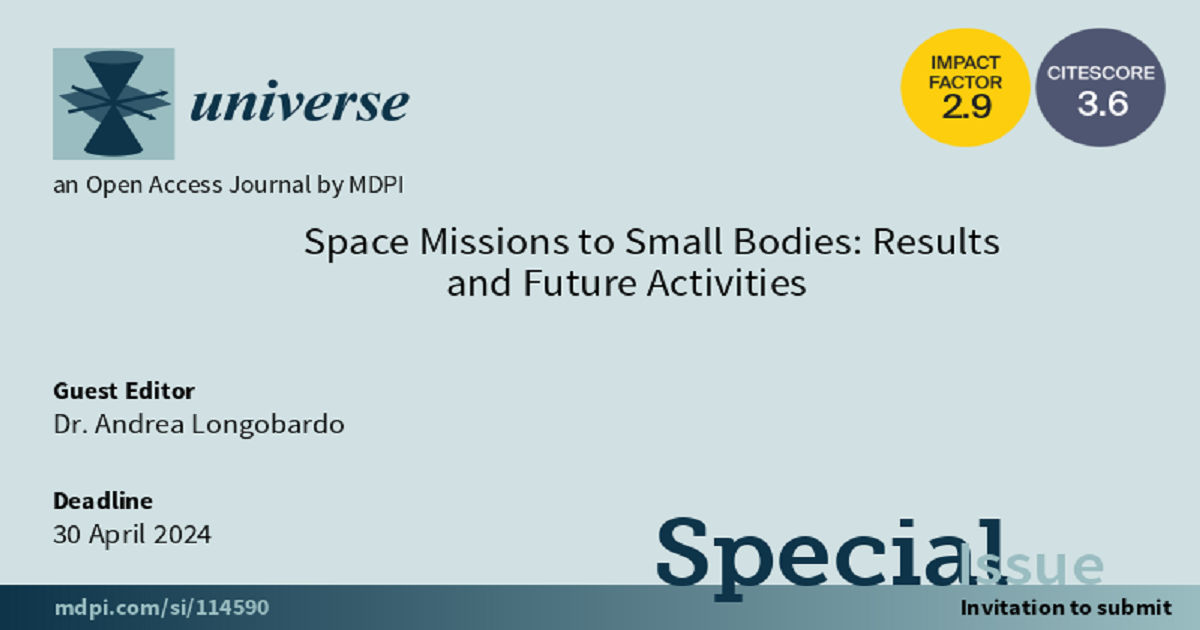Space Missions to Small Bodies: Results and Future Activities
A special issue of Universe (ISSN 2218-1997). This special issue belongs to the section "Planetary Sciences".
Deadline for manuscript submissions: 30 April 2024 | Viewed by 5274

Special Issue Editor
Special Issue Information
Dear Colleagues,
Small bodies (asteroids, comets, and satellites) are the most primitive bodies of the solar system and therefore crucial to understanding its origin and early evolution. Lately, the study of small bodies has advanced significantly thanks to space missions developed in recent years, which observed asteroids (Vesta, Trojan asteroids, Toutatis, Itokawa, Ryugu, Bennu), comets (67P/Churyumov-Gerasimenko), satellites (Moon), and dwarf planets (Ceres and Pluto). Nevertheless, other space missions will be launched in the coming years from all the main agencies around the world and will observe asteroids and comets never visited so far, as well as return samples from asteroids and satellites (Moon and Martian satellites). An important role is also being played by already launched and upcoming space telescopes, aimed at observing several small bodies of our solar system.
This Special Issue welcomes papers on new results concerning:
- Data analysis of space missions to small bodies, including observations from space telescopes and analysis of samples returned from Hayabusa, Hayabusa2, Chang’e 5, and previous sample return missions;
- Development of instruments, technologies, scientific activities, and software for future/upcoming missions to small bodies, including advances in sample return technology;
- Laboratory activity, supporting data interpretation and future missions to small bodies;
- Comparison between ground and space observations of small bodies.
Review papers on these topics are also welcome.
Dr. Andrea Longobardo
Guest Editor
Manuscript Submission Information
Manuscripts should be submitted online at www.mdpi.com by registering and logging in to this website. Once you are registered, click here to go to the submission form. Manuscripts can be submitted until the deadline. All submissions that pass pre-check are peer-reviewed. Accepted papers will be published continuously in the journal (as soon as accepted) and will be listed together on the special issue website. Research articles, review articles as well as short communications are invited. For planned papers, a title and short abstract (about 100 words) can be sent to the Editorial Office for announcement on this website.
Submitted manuscripts should not have been published previously, nor be under consideration for publication elsewhere (except conference proceedings papers). All manuscripts are thoroughly refereed through a single-blind peer-review process. A guide for authors and other relevant information for submission of manuscripts is available on the Instructions for Authors page. Universe is an international peer-reviewed open access monthly journal published by MDPI.
Please visit the Instructions for Authors page before submitting a manuscript. Submitted papers should be well formatted and use good English. Authors may use MDPI's English editing service prior to publication or during author revisions.
Keywords
- small bodies
- planetary science
- sample return
- comets
- asteroids
- satellites





